Gumbo
This post may contain affiliate links. Read my full disclosure policy.
Bring the flavor of the bayou home with this comforting gumbo, brimming with spicy andouille sausage and succulent shrimp.
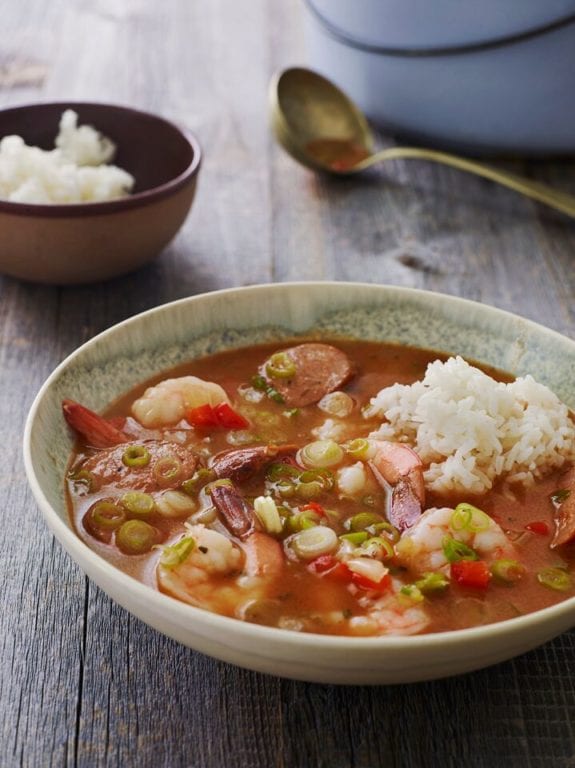
Photo by Alexandra Grablewski (Chronicle Books, 2018)
Gumbo, with its rich, soulful flavors, is more than just a comforting stew—it’s flavors are a nod to Louisiana’s rich history, blending Creole and Cajun traditions with influences from the West African, French, Spanish, and Native American folks who made this place their home. In fact, the name “gumbo” is thought to come from “ki ngombo,” the West African term for okra.
I can’t claim that this gumbo recipe is 100% authentic—there’s not even any okra or filé powder in it—but it is delicious and easy to make with ingredients found at your regular supermarket. And, really, there are no hard and fast rules when it comes to gumbo: each home and restaurant has their own version. The only necessity is the roux (pronounced “roo”), the mixture of fat and flour cooked on the stove until it becomes the color of chocolate, that forms the base of the stew. And of course the “holy trinity” of onions, bell peppers, and celery—those elements give the dish its signature flavor.
Table of Contents
“This gumbo is so tasty — there’s a depth of flavor and nice texture that I haven’t achieved with other gumbo recipes.”
What You’ll Need To Make Gumbo
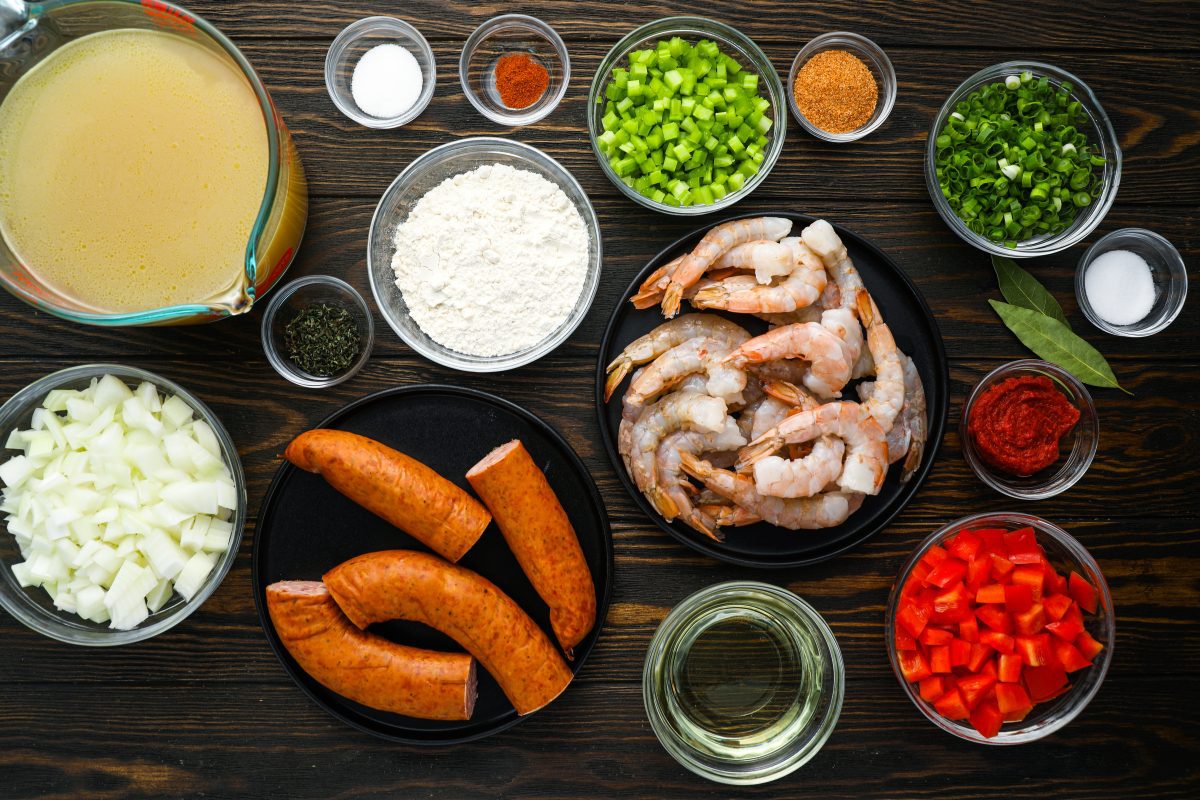
- Andouille (ahn-doo-ee) Sausage: A spicy, smoked pork sausage with roots in France but popular in Louisiana. In the supermarket, you’ll typically find it in the refrigerated meat section or alongside hot dogs and other specialty sausages. Since it’s already cooked, all you need to do is brown and heat it.
- Shrimp: Surprisingly, frozen shrimp can be fresher than what’s at the counter. Shrimp are usually flash-frozen right after being caught, preserving their freshness. “Fresh” shrimp at many counters were often frozen previously and then thawed, meaning they’ve been out of their frozen state longer.
- Holy Trinity: The heart and soul of many Louisiana dishes, this trio comprises onions, bell peppers, and celery. It acts as a flavorful foundation in recipes, capturing the essence of Louisiana cooking.
- Creole Seasoning: A spicy and aromatic blend of various herbs and spices, such as paprika, oregano, garlic powder, and cayenne pepper. It encapsulates the bold flavors of Louisiana. “Tony Chachere’s” or “Emeril’s Essence” are both widely recognized brands you can find in most supermarkets.
- Jump to the printable recipe for precise measurements
Step-By-Step Instructions
In a Dutch oven or large, heavy-bottomed pot, heat 1 tablespoon of the oil over medium-high heat. Add the sausages and brown on all sides, 5 to 7 minutes. Set the browned sausages aside on a cutting board.
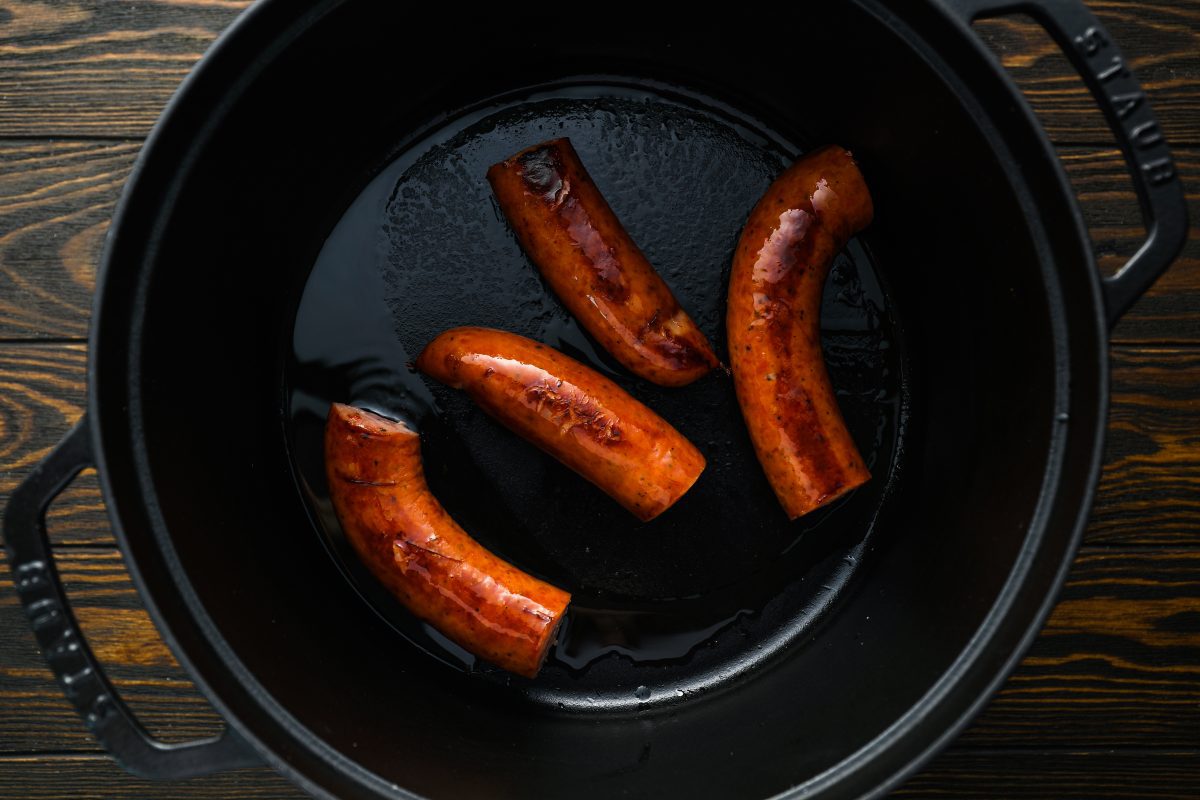
Lower the heat to medium and add the remaining 6 tablespoons of oil to the pot. Add the flour.
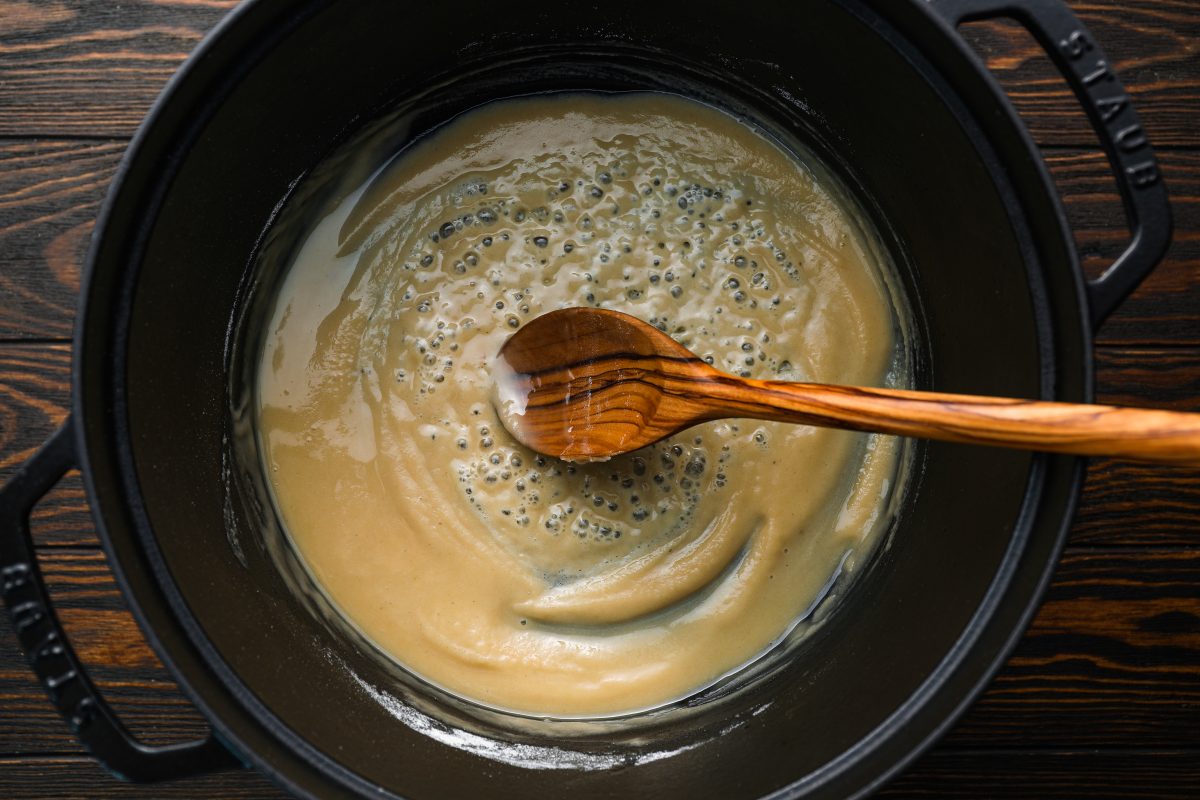
Cook, stirring slowly and constantly with a wooden spoon(making sure to scrape the corners of the pot).
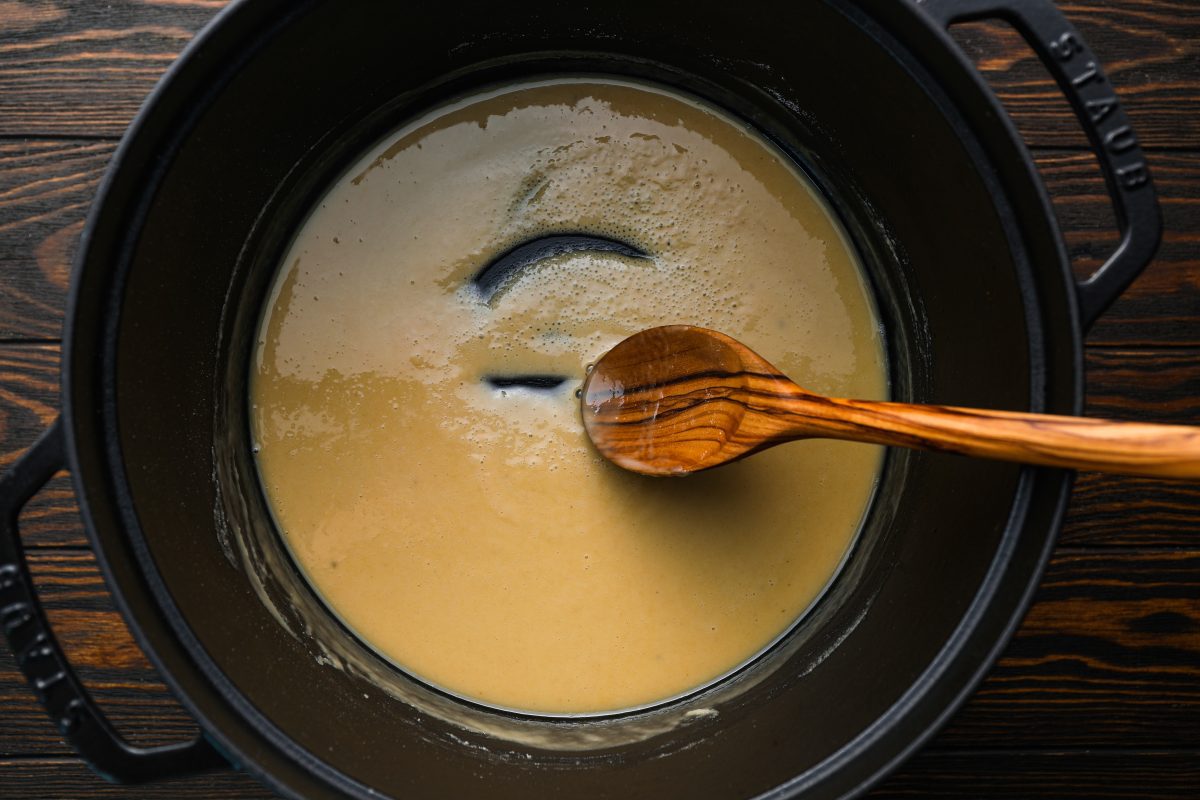
Continue stirring until the roux turns the color of milk chocolate.
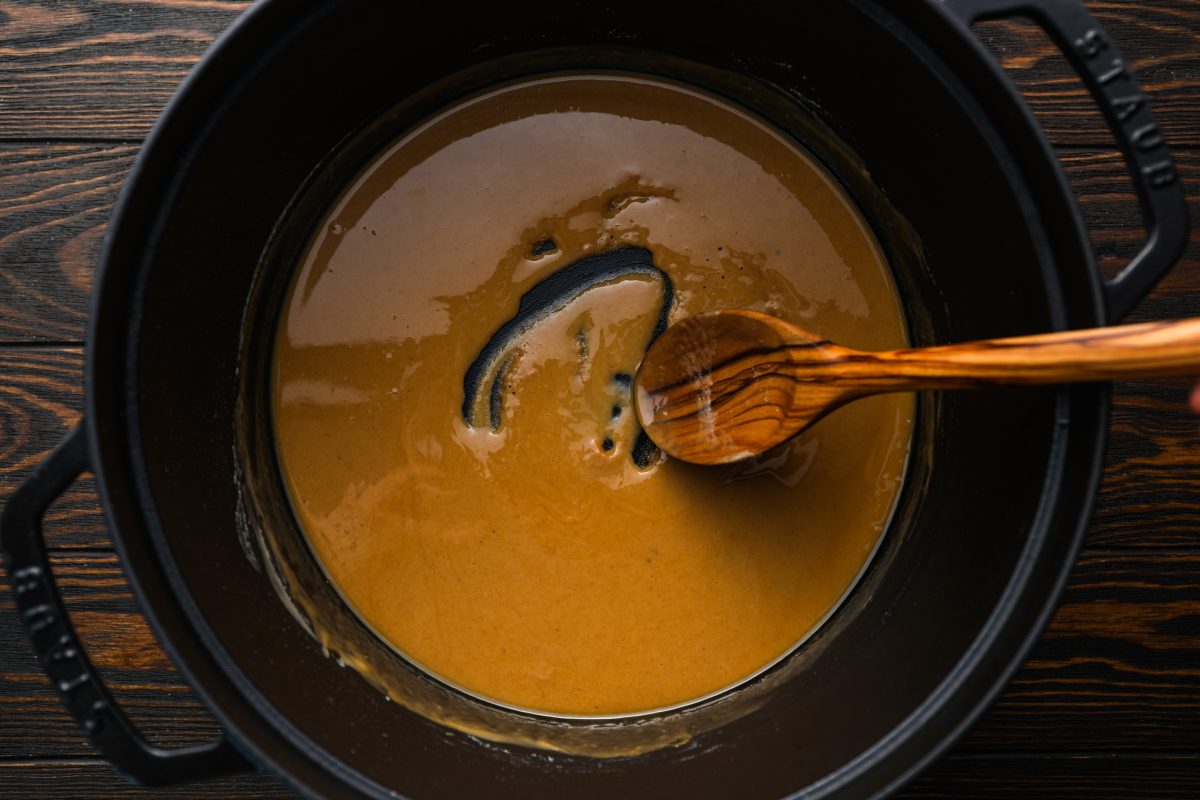
Depending on the type of pot you use, this process can take anywhere from 5 to 15 minutes; be patient to get the right color. (The roux will smell toasty as it browns—that’s okay, but if it starts to smoke at any point, turn the heat down or remove the pot from the heat for a moment.)
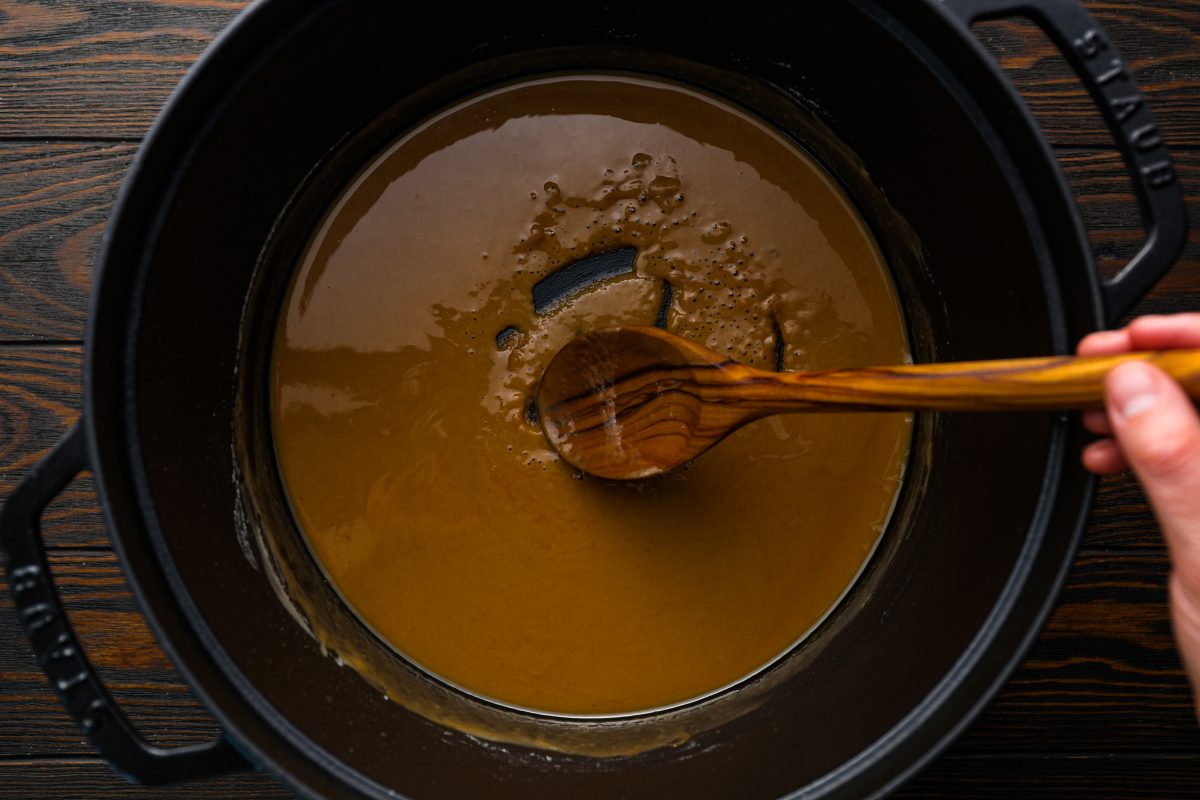
Add the onion, celery, and bell pepper and cook with the roux, stirring frequently, until softened, 7 to 9 minutes.
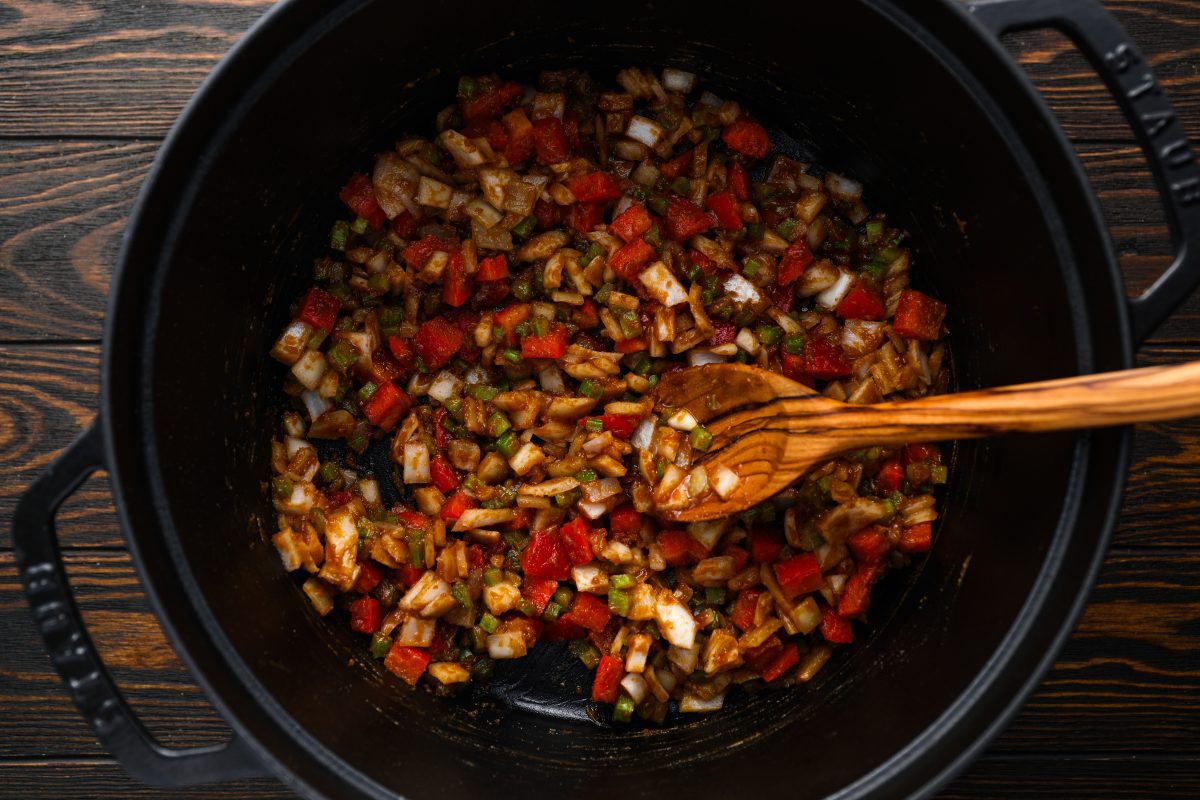
Gradually add the chicken broth. whisking to incorporate the roux as you go. Make sure to scrape the bottom and corners of the pot. Don’t worry if it looks like the roux isn’t blending with the broth; it will come together once it boils.
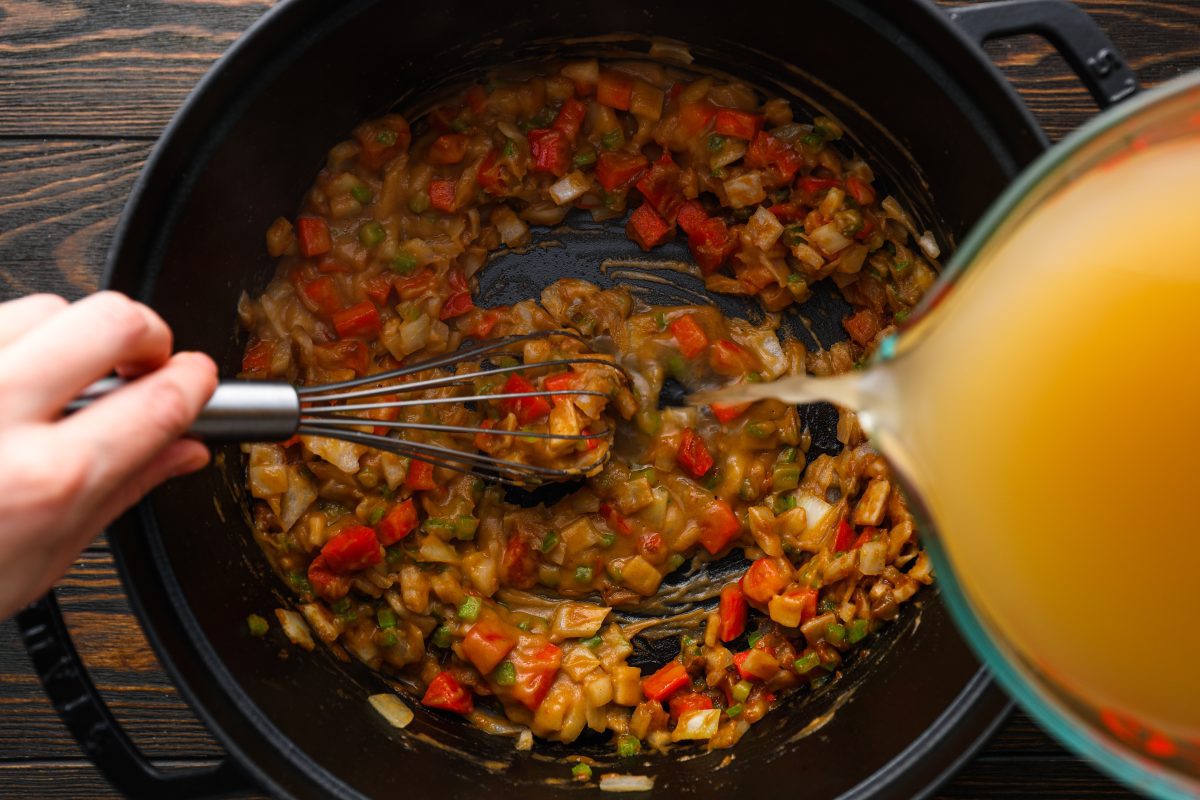
Stir in the tomato paste, salt, sugar, cayenne (if using), Creole seasoning, thyme, and bay leaves.
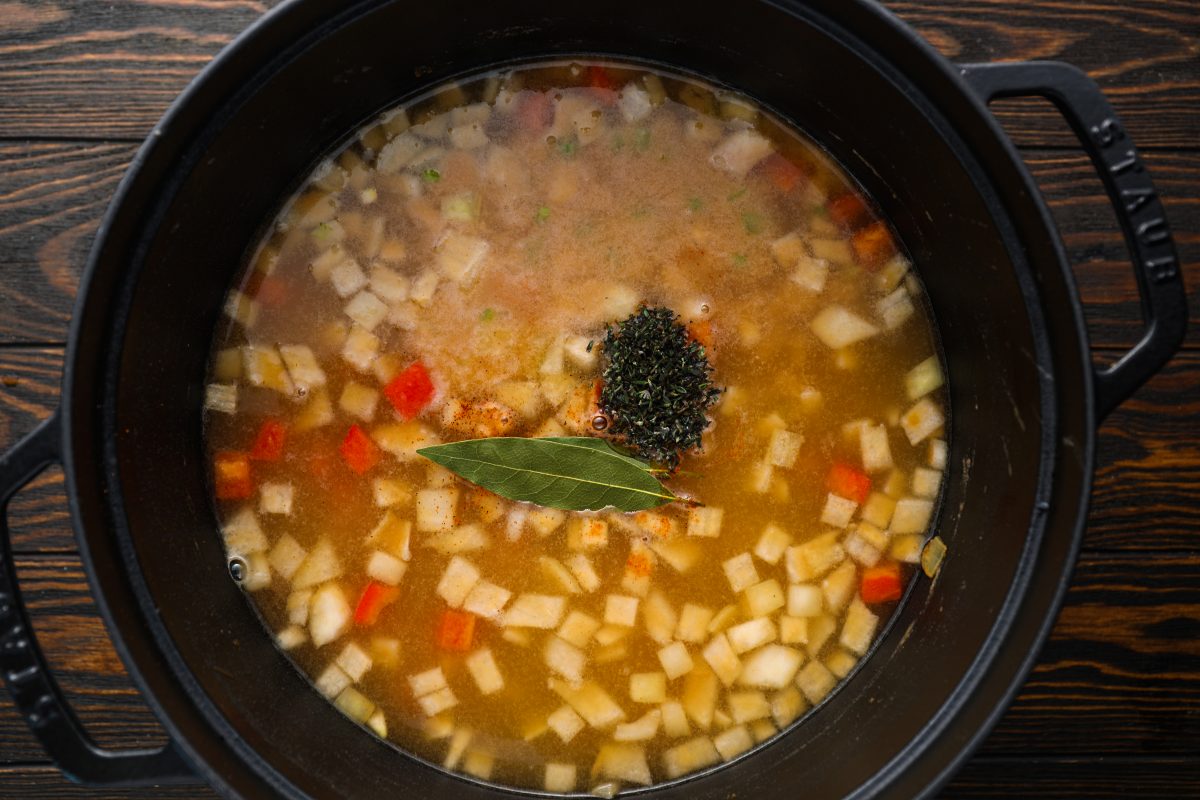
Bring to a boil, stirring frequently and scraping the bottom and corners of the pot where the roux may settle. Turn down the heat and simmer, uncovered and stirring occasionally, for 20 minutes.
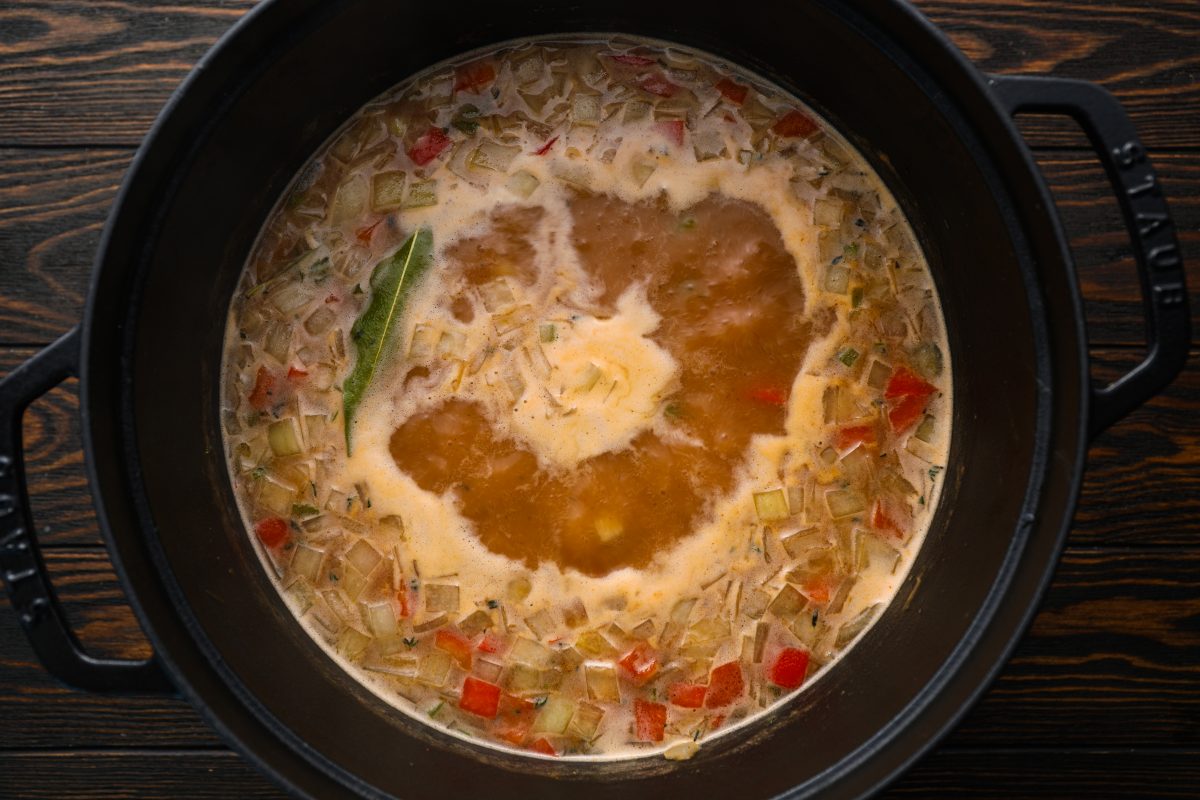
Meanwhile, cut the browned sausages on a diagonal into ½-inch slices. Add the sliced sausage and shrimp to the gumbo and simmer until the sausage is heated through and the shrimp are just cooked, 3 to 4 minutes.
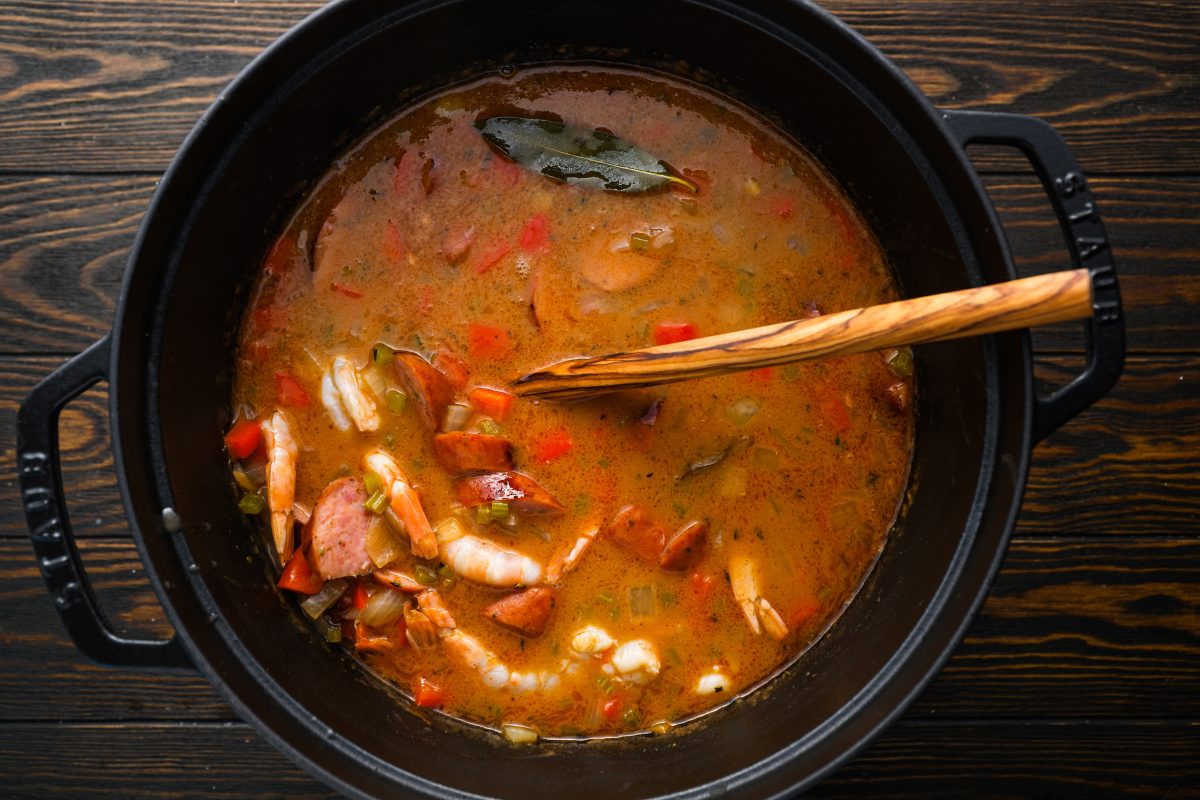
Remove and discard the bay leaves, and then stir in the scallions. Taste and adjust seasoning, if necessary.
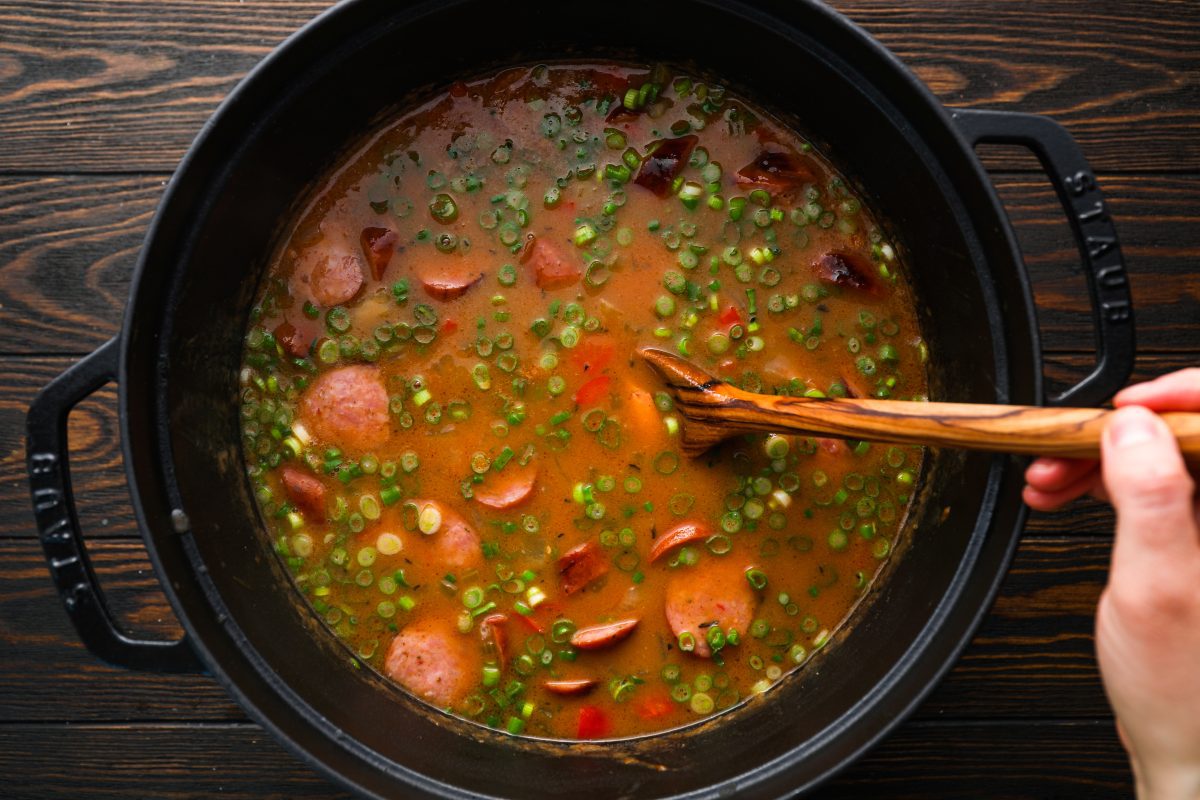
Spoon white rice into bowls and ladle the gumbo around the rice.
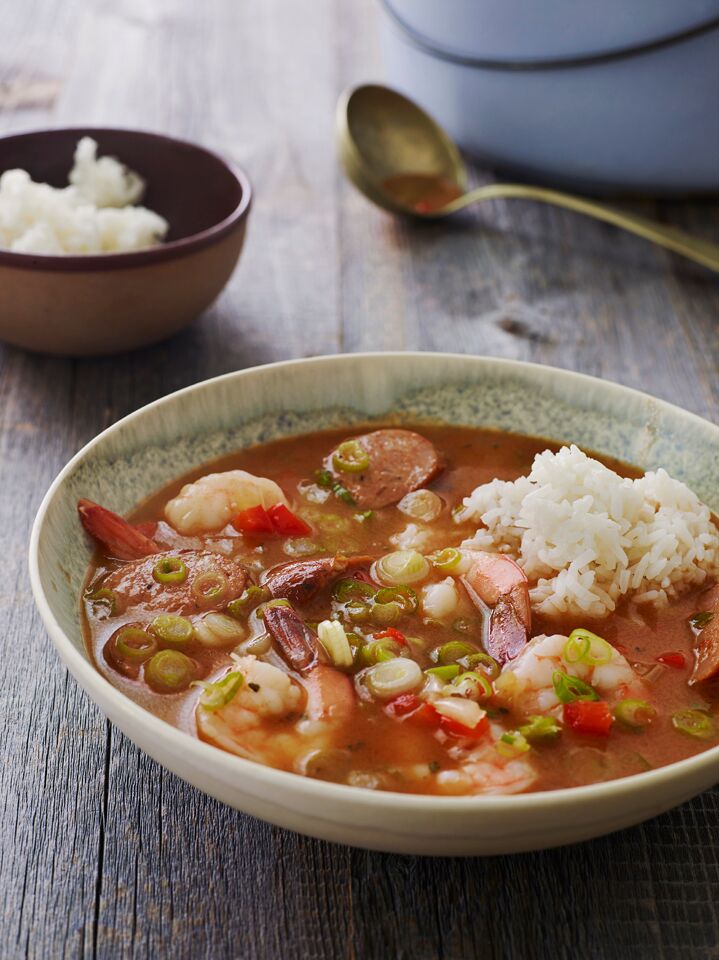
Frequently Asked Questions
My recipe omits okra and filé powder primarily for simplicity. While both are traditional thickeners in gumbo, I’ve chosen to rely solely on the roux to provide the dish’s body and depth. Also, depending on where you live, okra and filé powder can be hard to find; this version is made with easy-to-find ingredients.
The roux is fundamental to gumbo. It not only thickens the stew but also provides a distinct, rich flavor. Depending on the gumbo, the roux can range from a light tan to a deep chocolate brown. The darker the roux, the deeper and more complex the flavor will be, but it’s essential to cook it slowly to prevent burning.
The gumbo can be partially prepared, one day ahead of time, up until the point where you add the sliced sausage and shrimp to the broth. Before serving, simply bring the broth to a simmer and then proceed with the recipe.
Gumbo is best served fresh, but leftovers can be frozen in an airtight container for up to 3 months. Thaw in the refrigerator overnight before serving. When reheating, bring it to a gentle simmer over low heat. Be mindful that shrimp can become slightly tougher when reheated. (Freeze any leftover rice separately, as rice can become mushy when frozen and reheated in soup.)
Absolutely! At my house, everyone always fishes out the sausage and shrimp, leaving me with a huge pot of leftover broth. If your crew does the same, feel free to increase the sausage and shrimp in the recipe. If you have any leftover chicken in the fridge, you can throw that in too.
Video Tutorial
You May Also Like
Gumbo
Ingredients
- 7 tablespoons vegetable oil, divided
- 1½ pounds smoked Andouille sausage (see note)
- ¾ cup all-purpose flour
- 1½ cups chopped yellow onions, from one large onion
- 2 stalks celery, diced
- 1 red bell pepper, seeded and diced
- 7 cups low-sodium chicken broth
- 2 tablespoons tomato paste
- 1 teaspoon salt
- 1 teaspoon sugar
- ¼ teaspoon cayenne pepper (optional)
- 2½ teaspoons Creole seasoning, such as Emeril's Essence or Tony Cachere's
- 1 teaspoon chopped fresh thyme (or ½ teaspoon dried)
- 2 bay leaves
- 1½ pounds large shrimp, peeled and deveined
- ½ cup chopped scallions, white and green parts, from about 4 scallions
- Cooked white rice, for serving
Instructions
- In a Dutch oven or large, heavy-bottomed pot, heat 1 tablespoon of the oil over medium-high heat. Add the sausages and brown on all sides, 5 to 7 minutes. Set the browned sausages aside on a cutting board.
- Lower the heat to medium and add the remaining 6 tablespoons (90 ml) of oil to the pot. Add the flour and cook, stirring slowly and constantly with a wooden spoon and making sure to scrape the corners of the pot, until the roux turns the color of milk chocolate. Depending on the type of pot you use, this process can take anywhere from 5 to 15 minutes; be patient to get the right color. (The roux will smell toasty as it browns—that’s okay, but if it starts to smoke at any point, turn the heat down or remove the pot from the heat for a moment.)
- Add the onion, celery, and bell pepper and cook with the roux, stirring frequently, until softened, 7 to 9 minutes.
- Gradually add the chicken broth, whisking to incorporate the roux as you go, and making sure to scrape the bottom and corners of the pot. Don’t worry if it looks like the roux isn’t blending with the broth; it will come together once it boils.
- Stir in the tomato paste, salt, sugar, cayenne (if using), Creole seasoning, thyme, and bay leaves. Bring to a boil, stirring frequently and scraping the bottom and corners of the pot where the roux may settle. Turn down the heat and simmer, uncovered and stirring occasionally, for 20 minutes.
- Meanwhile, cut the browned sausages on a diagonal into ½-inch (12-mm) slices.
- Add the sliced sausage and shrimp to the gumbo and simmer until the sausage is heated through and the shrimp are just cooked, 3 to 4 minutes.
- Remove and discard the bay leaves, and then stir in the scallions. Spoon white rice into bowls and ladle the gumbo around the rice.
- Make-Ahead/Freezing Instructions: The gumbo can be partially prepared, one day ahead of time, up until the point where you add the sliced sausage and shrimp to the broth. Before serving, simply bring the broth to a simmer and then proceed with the recipe. Leftover gumbo can be frozen in an airtight container for up to 3 months. Thaw in the refrigerator overnight before reheating. When reheating, bring it to a gentle simmer over low heat. Be mindful that shrimp can become slightly tougher when reheated.
- Andouille is a seasoned and smoked sausage made from pork, most often associated with Louisiana Creole cuisine. You can usually find it in the cooked sausage section of your supermarket—and, since it’s already cooked, all you need to do is brown and heat it.
Pair with
Nutrition Information
This website is written and produced for informational purposes only. I am not a certified nutritionist and the nutritional data on this site has not been evaluated or approved by a nutritionist or the Food and Drug Administration. Nutritional information is offered as a courtesy and should not be construed as a guarantee. The data is calculated through an online nutritional calculator, Edamam.com. Although I do my best to provide accurate nutritional information, these figures should be considered estimates only. Varying factors such as product types or brands purchased, natural fluctuations in fresh produce, and the way ingredients are processed change the effective nutritional information in any given recipe. Furthermore, different online calculators provide different results depending on their own nutrition fact sources and algorithms. To obtain the most accurate nutritional information in a given recipe, you should calculate the nutritional information with the actual ingredients used in your recipe, using your preferred nutrition calculator.

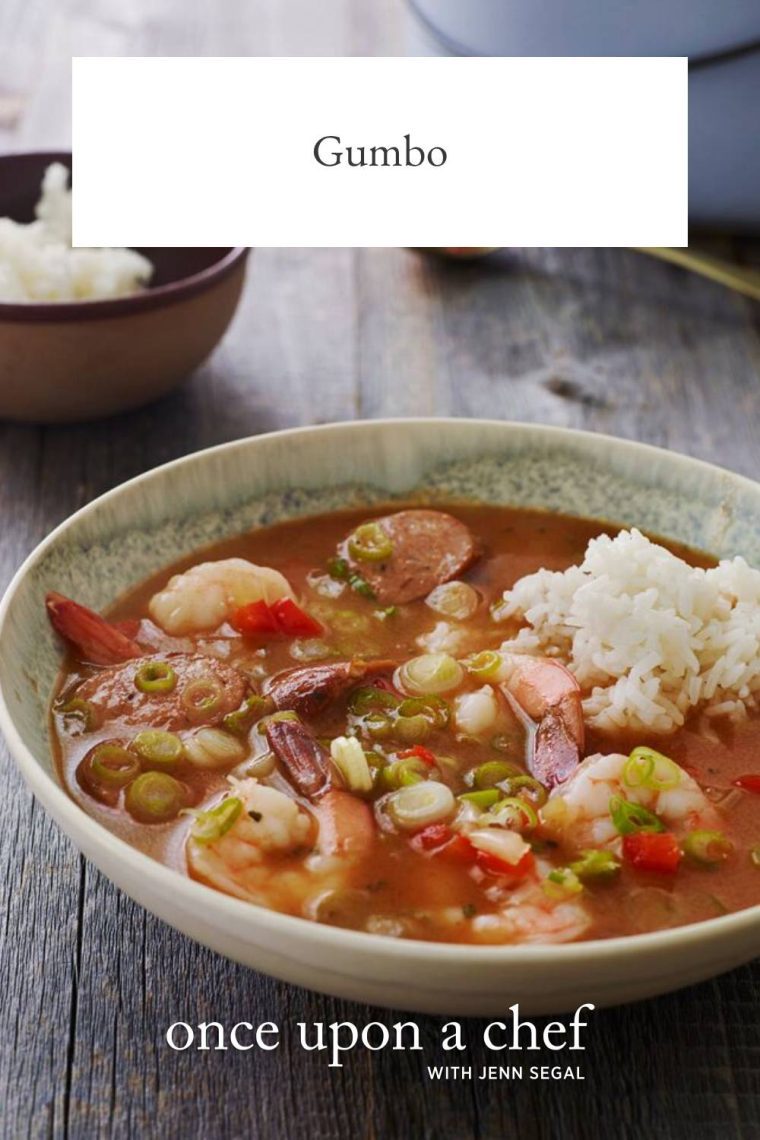
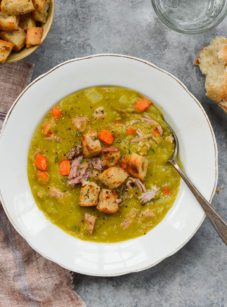
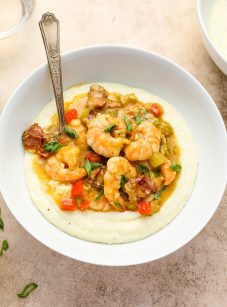



Hi Jenn,
With the cooler temps, I am planning to make this soon. Being a huge okra fan, I’d love to incorporate some into your recipe. Would you add it in with the trinity or when simmering for the 20 minutes? Thanks in advance!
Hi Candice, I’d add it about 5 minutes into the 20 minute simmering step. Enjoy!
Would this work with the same instructions if I were to divide all of the ingredients in half to serve four? There are only two in our household. We don’t need 8 servings but it looks great!
Sure!
I prepared the gumbo minus the shrimp/sausage today so I could let the base meld nicely and give me more time “out” of the kitchen to enjoy my visiting daughter..also made the biscuits today and will warm them to accompany the gumbo tomorrow..last time I enjoyed Gumbo was in Louisiana in the 60’s..so many beautiful memories creating this lovely meal.💓
I have made this recipe for gumbo many times and it is always delicious. No changes to the recipe are needed
Hi Jenn
Could I use sunflower or avocado oil in place of vegetable oil? Cannot wait to make this!!
Sure, I’d go with the avocado oil. Hope you enjoy!